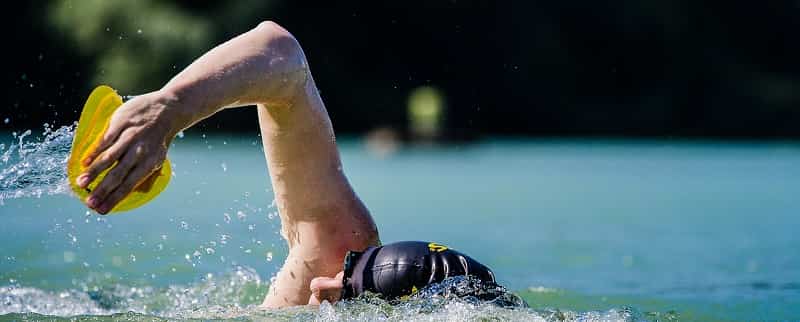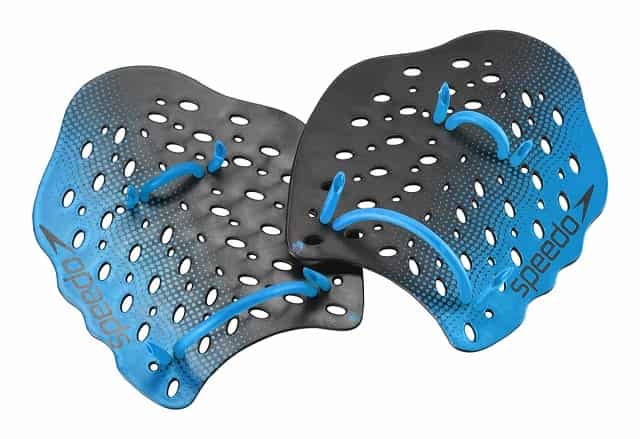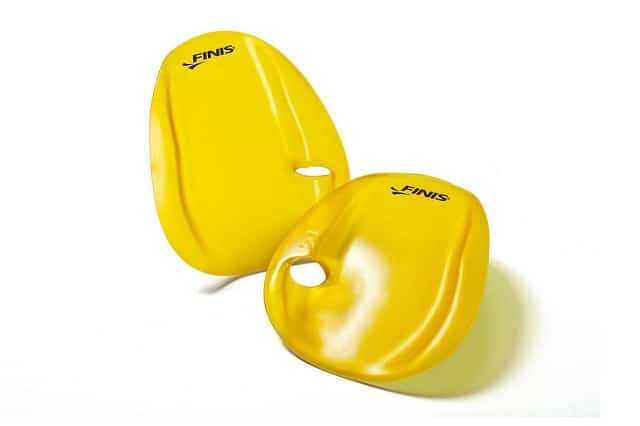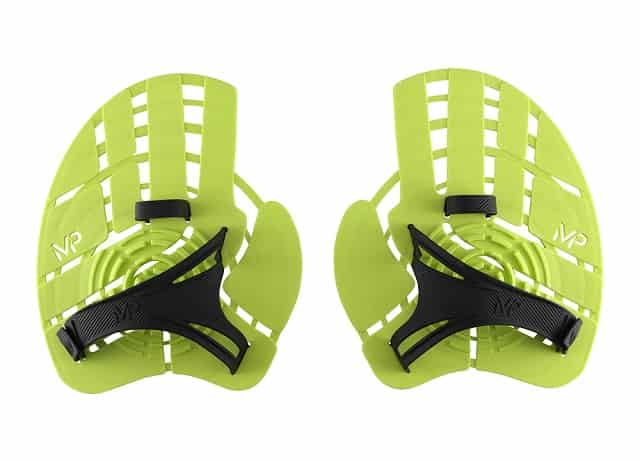To Paddle or not to Paddle?
 The Swimmer’s Ultimate Guide to Swim Paddles
The Swimmer’s Ultimate Guide to Swim Paddles
(This article was originally published in http://www.yourswimlog.com/ultimate-guide-swim-paddles/ and is published with the kind permission of Olivier, olivier@yourswimbook.com)
Swim paddles are a staple in just about every swimmer’s training. Here is everything you need to know about making the most of this piece of equipment.
“Fins and paddles!” coach called out.
A chorus of smiles and cheers swiftly followed. Some things are totally universal in our sport, and one of them is the pleasure in getting to Mach-1 while wearing equipment that throws our swimming into hyper-drive.
Paddles are one of those pieces of equipment that are found in just about every swim bag across the world, but have you ever really stopped to think about why we use them?
From how you should use them, the research behind their effectiveness, the shortcomings of their use, and even some links to some of the best rated paddles on the market, we are going to cover everything paddle related.
Here is just about everything you ever wanted to know about swim paddles.
Swim Paddles: The Research
As an experienced swimmer you have used them so many times that you have never really paused to consider the point of them. But you do know what happens when you strap them on: you swim longer (in terms of distance per stroke) and you swim faster.
The research backs this up:
- A group of female swimmers strapped on a pair of small hand paddles (116 cm) and over-sized paddles (286 m) and completed a series of 25m sprints. Both swimming speed and distance-per-stroke increased significantly.While DPS went up, the stroke rate went down. Of particular note was that the pulling phase took longer to execute, while the speed of the recovery was unchanged.
- In what is basically a copy of the previous study, this time a group of male age groupers swam a series of 25m sprints (the oversized paddles were bigger in this trial—311cm). They were instructed to hold a consistent stroke rate via an underwater speaker that helped them it constant. Same results:increased speed and distance per stroke, and handspeed in the push and in-sweep phases were down when wearing paddles.
- A group of nationally ranked backstrokers performed a bunch of 100s with and without paddles. When the 100s were swum at full max the rate of perceived exertion and blood lactate concentration were lower when swum with paddles compared to without. In other words, the paddles made the swimmers more efficient when they were swimming all-out, but interestingly enough, not when they were swimming at sub-maximal speed (85%).
- If you’ve swum for even a moderate amount of time you have stumbled upon swimmer’s shoulder, either yourself or in the warnings of others. Swim paddles, as well as other shoulder-bearing exercises, were found to be one of the things that aggravated shoulder injuries when used by swimmers and in this group of 1250+ swimmers from age group to national level.
The Benefits of Swim Paddles
There are generally two main benefits to incorporating paddles into your training: building power and strength in the water, and also to help solidify good technique habits.
Here’s why you should use paddles during swim training:
1. Specific development of power.
In terms of building strength and power this is about as specific as it gets. As long as you are performing the stroke precisely as you normally would (which can be hard with a slower catch and pull as shown in the research above), you are adding resistance to your stroke.
2. Teach you speed and efficiency.
You don’t need me to tell you that swimming with paddles is awesome because you get to go much faster—probably as fast or faster as race pace when going all-out. When swimming at this kind of speed you can really get a feel for how you are most efficient in the water, from keeping a rigid torso, to having an early catch, and so on.
3. Spices up your workout.
For those long, monotonous repeats of 500s or whatever coach is subjecting to you that day, throwing in some paddles is a an easy way to mix things up and keep you fresh mentally.
4. Encourages a better catch.
When you are feeling particularly hardcore use only the middle finger strap. When you don’t engage the early catch the paddle will slip off and you will be feeling like a rank amateur having to put your paddle back on mid-length. (On the bright side it will teach you what not to do.)
5. You’ll know when you aren’t pulling correctly.
Paddles accentuate everything about the pulling motion. Your catch is stronger, the pulling motion is stronger—you will be able to better focus and tune those parts of your stroke.

The Downsides
Everything is not all golden when it comes to your hand paddles, though. If you’ve ever had pain in your shoudlers you know that they tend to exacerbate the tenderness, and while they can encourage some good training habits in some instances they can also open the door to bad ones:
- Oversized paddles put strain on ligaments and tendons in your arms. If you have weak shoulders, or are experiencing a fresh round of the dreaded swimmers shoulder than large paddle use is probably not for you. Think of paddles like weights: if you have bad, shaky form in the water the potential for injury increases significantly.
- Leaves you slipping through the water afterwards. While gliding along at a reduced rate of exertion can make you feel like an aquatic superhero, taking them off—especially when rocking out with dinner plate-sized paddles on your hands—can leave you feeling like your hands are trying to catch sand the next time you push off.
- Paddles can encourage bad training habits. Just as often as they encourage good ones, throwing the dinner plates on your hands can also develop habits you are trying to steer clear of: from spreading the fingers, to having a gallop in the stroke from a slow pull but fast recovery, and so on.
Best Practices for Using Hand Paddles
Start with paddles just larger than your hands.
We all vary in terms of natural hand size and shoulder strength. You might have small hands but boulder-shoulders, and vice versa—so start with paddles that are just a little bit larger than your hands and progress from there.
The tendency is to start with dinner plates right off the bat (guilty!), but if it means that your stroke is unbearably slow or that its straining the tendons in your elbow than the paddles become a moot training tool.
Remove the wrist straps.
The last thing you want to do is throw on some paddles and start ingraining some less-than-rad training habits. By removing the wrist straps you will find out very quickly whether or not you are swimming with good technique, particularly in freestyle.
If you aren’t swimming with your “natural paddle”—the hand to elbow, and going for early vertical forearm at the beginning of the pulling motion, the paddle will slip right off. To be sure it is annoying when it happens, but it will keep you on your game technically.
Mimic natural finger position.
A common occurrence with really big paddles is for swimmers to spread their finger sin order to more evenly apply pressure across the paddle. If you need to do this the paddles are too large.
Similarly, if your fingers extend beyond the edge of the paddles you are going to naturally curl your finger tips around the edge of the paddle for more stability.
The Best Swim Paddles on the Market
Alrighty, so now that we have covered the ups, the downs, the benefits and downsides of using the bad boys, here are my choices for the top three paddles on the market.
1. Speed Power Plus Paddles.

I put these bad boys at number one because, well, they are in my swimming bag. The current set I have (the XL) are going on year three of working rather wonderfully.
I have taken the wrist straps in and out a few times with no visible wear or worrying that they would snap.
They would be in better shape if I took them out of my mesh bag once in a while and gave them a rinse, but hey, I’m kinda lazy when I get home after swimming for two hours.
They are available in small to extra large.
Where to Buy:
2. FINIS Agility Hand Paddles

When it comes to freestyle, crushing the catch and having a strong early vertical forearm separates the top of the pile from the rest. These paddles–which have no straps–are built specifically to insure that you are catching teh water early and fast.
(These paddles are also usable in other strokes, but as a freestyler myself this has been my experience using them.)
The premise of the Agility paddles is simple: swim with good technique or you are spending half the workout stopping mid-length to put them back on your hands.
Where to Buy
3. MP Michael Phelps Hand Paddle

Since the GOAT and Speedo parted ways a few years ago you got the sense that it was only a matter of time before he came out with a full line of swim gear. His entry into the swim paddle market is a strong one, with a raised contour under the palm, and vents/holes in the paddle to maintain a feel for the water.
His coach Bob Bowman helped in the design, and counts them among his favorite so far:
They give you the feel of the hand and the way it is when swimming because of the raised portion under the palm of your hand. It’s not a flat surface. You’re actually in a much more natural position.”
Bob Bowman



No Comments